Kaggle競賽丨入門手寫數字識別之KNN、CNN、降維
阿新 • • 發佈:2020-01-21
引言
- 這段時間來,看了西瓜書、藍皮書,各種機器學習演算法都有所瞭解,但在實踐方面卻缺乏相應的鍛鍊。於是我決定通過Kaggle這個平臺來提升一下自己的應用能力,培養自己的資料分析能力。
- 我個人的計劃是先從簡單的資料集入手如手寫數字識別、泰坦尼克號、房價預測,這些目前已經有豐富且成熟的方案可以參考,之後關注未來就業的方向如計算廣告、點選率預測,有合適的時機,再與小夥伴一同參加線上比賽。
資料集
介紹

MNIST ("Modified National Institute of Standards and Technology")是計算機視覺中最典型的資料集之一,其一共包含訓練集
train.csv,測試集test.csv和提交示例sample_submission.csv。csv是一種資料格式,以逗號作為檔案的分隔值。訓練集
train.csv包含40000張28*28=784的圖片,圖片畫素值為0-255,每張圖片有對應的標籤,其資料格式如下,可以看作是一個40000 * 785的矩陣,第一列存放標籤;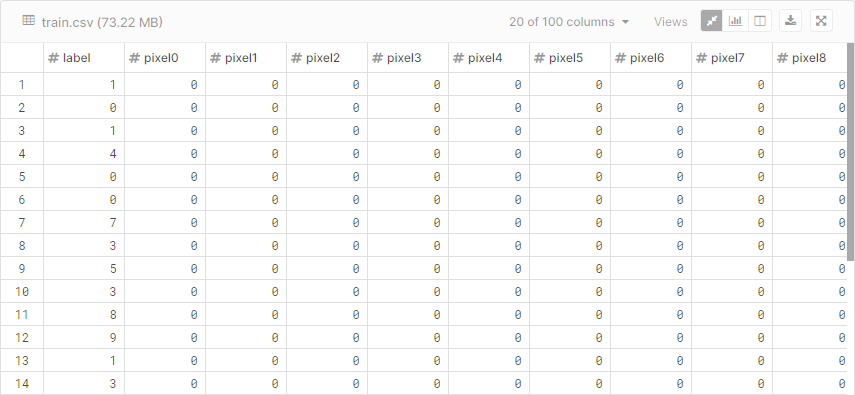
測試集
test.csv包含28000張28*28=784的圖片,其不提供標籤,矩陣維度為28000*784。
讀取資料集
觀察到不同方案中資料的讀取方法各不同,這裡小結一下。
- csv
def loadTrainData(): l=[] with open('/kaggle/input/digit-recognizer/train.csv') as file: lines = csv.reader(file) for line in lines: l.append(line)
- open
# load csv files to numpy arrays
def load_data(data_dir):
train_data = open(data_dir + "train.csv").read()- numpy
def load_data(path): with np.load(path) as f: x_train, y_train = f['x_train'], f['y_train'] x_test, y_test = f['x_test'], f['y_test'] return (x_train, y_train), (x_test, y_test)
- panda
train = pd.read_csv('../input/train.csv')K近鄰演算法KNN
- 這裡不再介紹kNN的原理,貼一個簡潔的實現,參考自https://blog.csdn.net/u012162613/article/details/41929171,其主要採用了二值化、L2範數作為距離度量。
實現A
from numpy import *
import csv
# 讀取訓練集
def loadTrainData():
l=[]
with open('/kaggle/input/digit-recognizer/train.csv') as file:
lines = csv.reader(file)
for line in lines:
l.append(line)
l.remove(l[0])
l=array(l)
data, label = l[:,1:], l[:,0]
label = label[:,newaxis]
a = normalizing(toInt(data))
b = toInt(label)
return a, b
# 字元轉整形
def toInt(array):
array = mat(array)
m,n = shape(array)
newArray = zeros((m,n))
for i in range(m):
for j in range(n):
newArray[i,j]=int(array[i,j])
return newArray
# 二值化處理
def normalizing(array):
m,n = shape(array)
for i in range(m):
for j in range(n):
if array[i,j] != 0:
array[i,j]=1
return array
# 載入測試集
def loadTestData():
l=[]
with open('/kaggle/input/digit-recognizer/test.csv') as file:
lines = csv.reader(file)
for line in lines:
l.append(line)
l.remove(l[0])
l=array(l)
data=l
return normalizing(toInt(data))
def loadTestResult():
l=[]
with open('/kaggle/input/digit-recognizer/sample_submission.csv') as file:
lines = csv.reader(file)
for line in lines:
l.append(line)
l.remove(l[0])
l=array(l)
label=l[:,1]
label = label[:, newaxis]
return toInt(label)
# 儲存結果
def saveResult(result):
with open('/kaggle/working/knn.csv', 'w', newline='') as myFile:
myWriter = csv.writer(myFile)
myWriter.writerow(['ImageId','Label'])
for i, label in enumerate(result):
tmp = [i+1, int(label)]
myWriter.writerow(tmp)
# kNN分類
def classify(inX, dataSet, labels, k):
inX = mat(inX)
dataSet = mat(dataSet)
labels = mat(labels)
dataSetSize = dataSet.shape[0]
diffMat = tile(inX, (dataSetSize, 1)) - dataSet
spDiffMat = array(diffMat) ** 2
spDistances = spDiffMat.sum(axis=1)
#計算L2距離
distances = spDistances ** 0.5
sortedDistIndicies = distances.argsort()
classCount = {}
for i in range(k):
voteIlabel = labels[sortedDistIndicies[i],0]
classCount[voteIlabel] = classCount.get(voteIlabel,0) + 1
sortedClassCount = sorted(classCount.items(), key=lambda item:item[1], reverse=True)
return sortedClassCount[0][0]
# 主函式
def handwritingClassTest():
trainData,trainLabel=loadTrainData()
testData =loadTestData()
testLabel = loadTestResult()
m,n=shape(testData)
errorCount=0
resultList=[]
for i in range(m):
classifierResult = classify(testData[i], trainData, trainLabel, 1)
resultList.append(classifierResult)
print("the classifier for %d came back with: %d, the real answer is: %d" % (i, classifierResult, testLabel[i]))
if (classifierResult != testLabel[i]): errorCount += 1.0
print("\nthe total number of errors is: %d" % errorCount)
print("\nthe total error rate is: %f" % (errorCount/float(m)))
saveResult(resultList)
handwritingClassTest()- 結果:k=5,準確率96.40%;k=1,準確率96.27%。PS:按照個人理解,K值越小,結果應該更高才對。隨後我換了另一個實現,其採用了numpy實現矩陣計算,執行速度比上面的程式碼塊多了。
實現B
import numpy as np
import matplotlib.pyplot as plt
from collections import Counter
import time
%matplotlib inline
plt.rcParams['figure.figsize'] = (10.0, 8.0) # set default size of plots
plt.rcParams['image.interpolation'] = 'nearest'
plt.rcParams['image.cmap'] = 'gray'
# load csv files to numpy arrays
def load_data(data_dir):
train_data = open(data_dir + "train.csv").read()
train_data = train_data.split("\n")[1:-1]
train_data = [i.split(",") for i in train_data]
# print(len(train_data))
X_train = np.array([[int(i[j]) for j in range(1,len(i))] for i in train_data])
y_train = np.array([int(i[0]) for i in train_data])
# print(X_train.shape, y_train.shape)
test_data = open(data_dir + "test.csv").read()
test_data = test_data.split("\n")[1:-1]
test_data = [i.split(",") for i in test_data]
# print(len(test_data))
X_test = np.array([[int(i[j]) for j in range(0,len(i))] for i in test_data])
# print(X_test.shape)
return X_train, y_train, X_test
class simple_knn():
"a simple kNN with L2 distance"
def __init__(self):
pass
def train(self, X, y):
self.X_train = X
self.y_train = y
def predict(self, X, k=1):
dists = self.compute_distances(X)
# print("computed distances")
num_test = dists.shape[0]
y_pred = np.zeros(num_test)
for i in range(num_test):
k_closest_y = []
labels = self.y_train[np.argsort(dists[i,:])].flatten()
# find k nearest lables
k_closest_y = labels[:k]
# out of these k nearest lables which one is most common
# for 5NN [1, 1, 1, 2, 3] returns 1
# break ties by selecting smaller label
# for 5NN [1, 2, 1, 2, 3] return 1 even though 1 and 2 appeared twice.
c = Counter(k_closest_y)
y_pred[i] = c.most_common(1)[0][0]
return(y_pred)
def compute_distances(self, X):
num_test = X.shape[0]
num_train = self.X_train.shape[0]
dot_pro = np.dot(X, self.X_train.T)
sum_square_test = np.square(X).sum(axis = 1)
sum_square_train = np.square(self.X_train).sum(axis = 1)
dists = np.sqrt(-2 * dot_pro + sum_square_train + np.matrix(sum_square_test).T)
return(dists) # runs for 13 minutes
predictions = []
for i in range(int(len(X_test)/(2*batch_size))):
# predicts from i * batch_size to (i+1) * batch_size
print("Computing batch " + str(i+1) + "/" + str(int(len(X_test)/batch_size)) + "...")
tic = time.time()
predts = classifier.predict(X_test[i * batch_size:(i+1) * batch_size], k)
toc = time.time()
predictions = predictions + list(predts)
# print("Len of predictions: " + str(len(predictions)))
print("Completed this batch in " + str(toc-tic) + " Secs.")
print("Completed predicting the test data.")
# runs for 13 minutes
# uncomment predict lines to predict second half of test data
for i in range(int(len(X_test)/(2*batch_size)), int(len(X_test)/batch_size)):
# predicts from i * batch_size to (i+1) * batch_size
print("Computing batch " + str(i+1) + "/" + str(int(len(X_test)/batch_size)) + "...")
tic = time.time()
predts = classifier.predict(X_test[i * batch_size:(i+1) * batch_size], k)
toc = time.time()
predictions = predictions + list(predts)
# print("Len of predictions: " + str(len(predictions)))
print("Completed this batch in " + str(toc-tic) + " Secs.")
print("Completed predicting the test data.")
out_file = open("predictions.csv", "w")
out_file.write("ImageId,Label\n")
for i in range(len(predictions)):
out_file.write(str(i+1) + "," + str(int(predictions[i])) + "\n")
out_file.close()- 結果:K=5,96.90%,k=1,97.11%;相同的k值,實現B的準確率比實現A要高,原因是實現B未採用二值化,保留了更多的數字影象資訊。
卷積神經網路CNN
- 這裡主要基於Pytorch實現。
資料載入
- 這裡transform的作用是將PIL圖片轉化為Tensor,並進行歸一化。具體可參考:https://zhuanlan.zhihu.com/p/27382990
# Construct the transform
import torchvision.transforms as transforms
from PIL import Image
transform = transforms.Compose([
transforms.ToTensor(),
transforms.Normalize((0.5,), (0.5,))
])
# Get the device we're training on
device = torch.device("cuda" if torch.cuda.is_available() else "cpu")
def get_digits(df):
"""Loads images as PyTorch tensors"""
# Load the labels if they exist
# (they wont for the testing data)
labels = []
start_inx = 0
if 'label' in df.columns:
labels = [v for v in df.label.values]
start_inx = 1
# Load the digit information
digits = []
for i in range(df.pixel0.size):
digit = df.iloc[i].astype(float).values[start_inx:]
digit = np.reshape(digit, (28,28))
digit = transform(digit).type('torch.FloatTensor')
if len(labels) > 0:
digits.append([digit, labels[i]])
else:
digits.append(digit)
return digits- SubsetRandomSampler對資料進行隨機劃分,num_workers採用多執行緒載入資料。可參考:https://stackoverflow.com/questions/53998282/how-does-the-number-of-workers-parameter-in-pytorch-dataloader-actually-work
# Load the training data
train_X = get_digits(train)
# Some configuration parameters
num_workers = 0 # number of subprocesses to use for data loading
batch_size = 64 # how many samples per batch to load
valid_size = 0.2 # percentage of training set to use as validation
# Obtain training indices that will be used for validation
num_train = len(train_X)
indices = list(range(num_train))
np.random.shuffle(indices)
split = int(np.floor(valid_size * num_train))
train_idx, valid_idx = indices[split:], indices[:split]
# Define samplers for obtaining training and validation batches
from torch.utils.data.sampler import SubsetRandomSampler
train_sampler = SubsetRandomSampler(train_idx)
valid_sampler = SubsetRandomSampler(valid_idx)
# Construct the data loaders
train_loader = torch.utils.data.DataLoader(train_X, batch_size=batch_size,
sampler=train_sampler, num_workers=num_workers)
valid_loader = torch.utils.data.DataLoader(train_X, batch_size=batch_size,
sampler=valid_sampler, num_workers=num_workers)
# Test the size and shape of the output
dataiter = iter(train_loader)
images, labels = dataiter.next()
print(type(images))
print(images.shape)
print(labels.shape)
網路模型
- 網路的結果主要分為
cnn_layers和fc_layers,個人認為fc_layers有些繁雜。
# Import the necessary modules
import torch.nn as nn
def calc_out(in_layers, stride, padding, kernel_size, pool_stride):
"""
Helper function for computing the number of outputs from a
conv layer
"""
return int((1+(in_layers - kernel_size + (2*padding))/stride)/pool_stride)
# define the CNN architecture
class Net(nn.Module):
def __init__(self):
super(Net, self).__init__()
# Some helpful values
inputs = [1,32,64,64]
kernel_size = [5,5,3]
stride = [1,1,1]
pool_stride = [2,2,2]
# Layer lists
layers = []
self.out = 28
self.depth = inputs[-1]
for i in range(len(kernel_size)):
# Get some variables
padding = int(kernel_size[i]/2)
# Define the output from this layer
self.out = calc_out(self.out, stride[i], padding,
kernel_size[i], pool_stride[i])
# convolutional layer 1
layers.append(nn.Conv2d(inputs[i], inputs[i], kernel_size[i],
stride=stride[i], padding=padding))
layers.append(nn.ReLU())
# convolutional layer 2
layers.append(nn.Conv2d(inputs[i], inputs[i+1], kernel_size[i],
stride=stride[i], padding=padding))
layers.append(nn.ReLU())
# maxpool layer
layers.append(nn.MaxPool2d(pool_stride[i],pool_stride[i]))
layers.append(nn.Dropout(p=0.2))
self.cnn_layers = nn.Sequential(*layers)
print(self.depth*self.out*self.out)
# Now for our fully connected layers
layers2 = []
layers2.append(nn.Dropout(p=0.2))
layers2.append(nn.Linear(self.depth*self.out*self.out, 512))
layers2.append(nn.Dropout(p=0.2))
layers2.append(nn.Linear(512, 256))
layers2.append(nn.Dropout(p=0.2))
layers2.append(nn.Linear(256, 256))
layers2.append(nn.Dropout(p=0.2))
layers2.append(nn.Linear(256, 10))
self.fc_layers = nn.Sequential(*layers2)
self.fc_last = nn.Linear(self.depth*self.out*self.out, 10)
def forward(self, x):
x = self.cnn_layers(x)
x = x.view(-1, self.depth*self.out*self.out)
x = self.fc_layers(x)
# x = self.fc_last(x)
return x
# create a complete CNN
model = Net()
model
模型訓練
- 定義優化器,這裡採用Adam。
import torch.optim as optim
# specify loss function
criterion = nn.CrossEntropyLoss()
# specify optimizer
optimizer = optim.Adam(model.parameters(), lr=0.0005)
- 採用交叉驗證法,即從訓練集中劃分一定比例的驗證集作為評價標準,防止過擬合。
# number of epochs to train the model
n_epochs = 25 # you may increase this number to train a final model
valid_loss_min = np.Inf # track change in validation loss
# Additional rotation transformation
#rand_rotate = transforms.Compose([
# transforms.ToPILImage(),
# transforms.RandomRotation(20),
# transforms.ToTensor()
#])
# Get the device
print(device)
model.to(device)
tLoss, vLoss = [], []
for epoch in range(n_epochs):
# keep track of training and validation loss
train_loss = 0.0
valid_loss = 0.0
#########
# train #
#########
model.train()
for data, target in train_loader:
# move tensors to GPU if CUDA is available
data = data.to(device)
target = target.to(device)
# clear the gradients of all optimized variables
optimizer.zero_grad()
# forward pass: compute predicted outputs by passing inputs to the model
output = model(data)
# calculate the batch loss
loss = criterion(output, target)
# backward pass: compute gradient of the loss with respect to model parameters
loss.backward()
# perform a single optimization step (parameter update)
optimizer.step()
# update training loss
train_loss += loss.item()*data.size(0)
############
# validate #
############
model.eval()
for data, target in valid_loader:
# move tensors to GPU if CUDA is available
data = data.to(device)
target = target.to(device)
# forward pass: compute predicted outputs by passing inputs to the model
output = model(data)
# calculate the batch loss
loss = criterion(output, target)
# update average validation loss
valid_loss += loss.item()*data.size(0)
# calculate average losses
train_loss = train_loss/len(train_loader.dataset)
valid_loss = valid_loss/len(valid_loader.dataset)
tLoss.append(train_loss)
vLoss.append(valid_loss)
# print training/validation statistics
print('Epoch: {} \tTraining Loss: {:.6f} \tValidation Loss: {:.6f}'.format(
epoch, train_loss, valid_loss))
# save model if validation loss has decreased
if valid_loss <= valid_loss_min:
print('Validation loss decreased ({:.6f} --> {:.6f}). Saving model ...'.format(
valid_loss_min,
valid_loss))
torch.save(model.state_dict(), 'model_cifar.pt')
valid_loss_min = valid_loss
- 繪製Loss曲線
# Plot the resulting loss over time
plt.plot(tLoss, label='Training Loss')
plt.plot(vLoss, label='Validation Loss')
plt.legend();
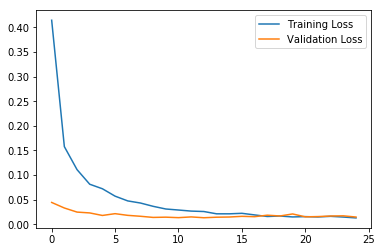
訓練結果
- 這裡只展示模型在驗證集上的結果,採用混淆矩陣表示(Confusion Matrix)。
該矩陣中\((i,j)\)表示原本為\(i\)的樣本被判定為\(j\)的數目。理想情況不存在誤判,只有對角線上有值,其他部分為0。但我們的結果顯示多多少少存在一些誤判,比如\((9,4)\)表示原本為9的樣本被誤判為了4,這可以理解,因為4和9確實很相近。
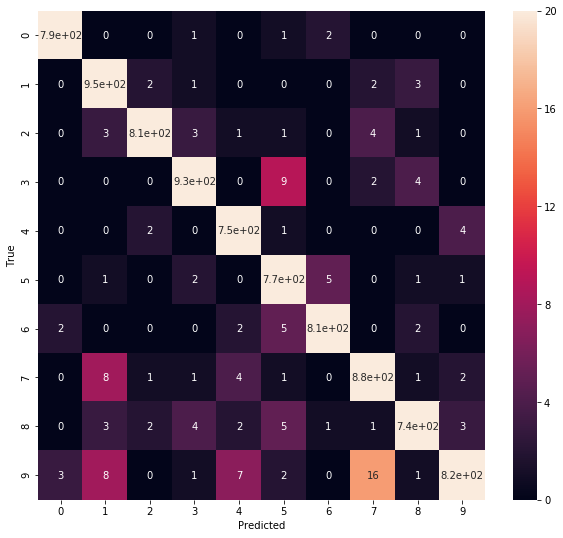
測試結果
- 載入訓練權重
model.load_state_dict(torch.load('model_cifar.pt'));
- 載入測試集
# Define the test data loader
test = pd.read_csv("../input/digit-recognizer/test.csv")
test_X = get_digits(test)
test_loader = torch.utils.data.DataLoader(test_X, batch_size=batch_size,
num_workers=num_workers)
- 預測並儲存結果
# Create storage objects
ImageId, Label = [],[]
# Loop through the data and get the predictions
for data in test_loader:
# Move tensors to GPU if CUDA is available
data = data.to(device)
# Make the predictions
output = model(data)
# Get the most likely predicted digit
_, pred = torch.max(output, 1)
for i in range(len(pred)):
ImageId.append(len(ImageId)+1)
Label.append(pred[i].cpu().numpy())
sub = pd.DataFrame(data={'ImageId':ImageId, 'Label':Label})
sub.describe
# Write to csv file ignoring index column
sub.to_csv("submission.csv", index=False)
- 最終的結果是98.90%,比KNN要高接近兩個點,而我將網路模型中的
fc_layers替換成一層普通的全連線層後,結果變成了99.21%。
降維Dimensionality Reduction
- 在高維資料下,演算法的效能可能會變得很差,即維度災難。因此我們使用降維方法將資料從高維投影到低維,這樣學習演算法將會簡單很多。
主成幹分析PCA
PCA是一類線性變換,將原始特徵投射到子空間並且儘可能保留資訊。因此演算法嘗試尋找最合適的方向和角度(即主成分)來最大化子空間的方差。
演算法
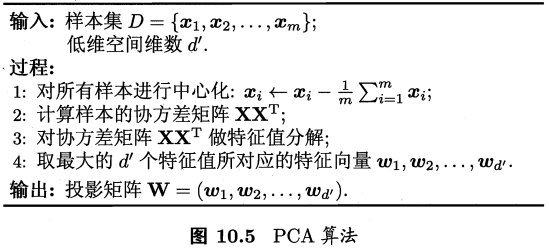
實現
# Standardize the data from sklearn.preprocessing import StandardScaler X = train.values X_std = StandardScaler().fit_transform(X) # Calculating Eigenvectors and eigenvalues of Cov matirx mean_vec = np.mean(X_std, axis=0) cov_mat = np.cov(X_std.T) eig_vals, eig_vecs = np.linalg.eig(cov_mat) # Create a list of (eigenvalue, eigenvector) tuples eig_pairs = [ (np.abs(eig_vals[i]),eig_vecs[:,i]) for i in range(len(eig_vals))] # Sort the eigenvalue, eigenvector pair from high to low eig_pairs.sort(key = lambda x: x[0], reverse= True) # Calculation of Explained Variance from the eigenvalues tot = sum(eig_vals) var_exp = [(i/tot)*100 for i in sorted(eig_vals, reverse=True)] # Individual explained variance cum_var_exp = np.cumsum(var_exp) # Cumulative explained variance視覺化
- 單獨的方差(黑色)隨著維度增大而減小,累計方差隨著維度的增大而飽和。90%的方差可用前200個維度來表示。

視覺化PCA找到的前30個最大方差方向上的特徵值。
# Invoke SKlearn's PCA method n_components = 30 pca = PCA(n_components=n_components).fit(train.values) eigenvalues = pca.components_.reshape(n_components, 28, 28) # Extracting the PCA components ( eignevalues ) #eigenvalues = pca.components_.reshape(n_components, 28, 28) eigenvalues = pca.components_ n_row = 4 n_col = 7 # Plot the first 8 eignenvalues plt.figure(figsize=(13,12)) for i in list(range(n_row * n_col)): offset =0 plt.subplot(n_row, n_col, i + 1) plt.imshow(eigenvalues[i].reshape(28,28), cmap='jet') title_text = 'Eigenvalue ' + str(i + 1) plt.title(title_text, size=6.5) plt.xticks(()) plt.yticks(()) plt.show()
用5個特徵做PCA並可視化前2個特徵(程式碼略),資料點被分為幾個叢集,每個叢集就是一類數字。
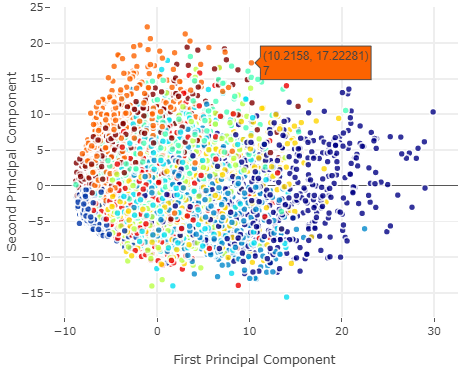
由於PCA是無監督方法,這裡也沒有提供標籤,於是我們接著採用K-means聚類演算法並可視化。
from sklearn.cluster import KMeans # KMeans clustering # Set a KMeans clustering with 9 components ( 9 chosen sneakily ;) as hopefully we get back our 9 class labels) kmeans = KMeans(n_clusters=9) # Compute cluster centers and predict cluster indices X_clustered = kmeans.fit_predict(X_5d)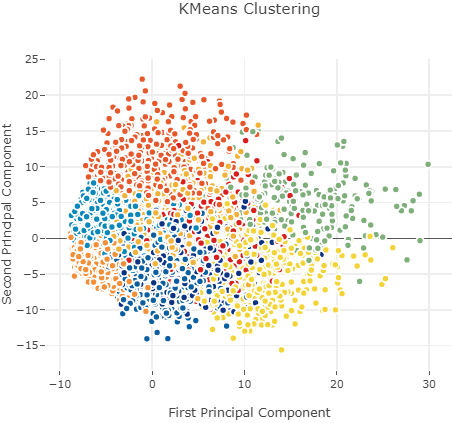
線性判別分析LDA
參考https://www.cnblogs.com/pinard/p/6244265.html
LDA跟PCA一樣,也採用線性降維,但其是監督的。
演算法過程如下
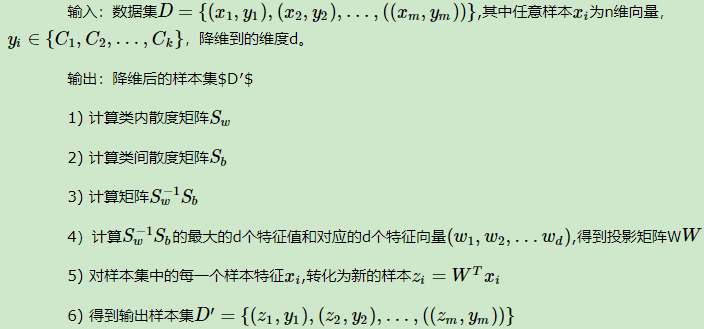
實現、視覺化
lda = LDA(n_components=5) # Taking in as second argument the Target as labels X_LDA_2D = lda.fit_transform(X_std, Target.values )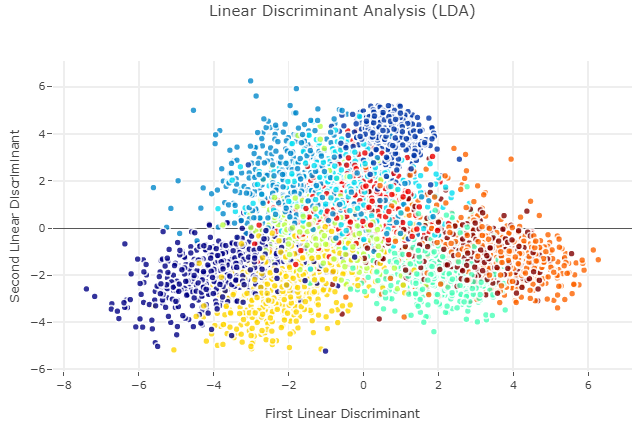
LDA vs PCA
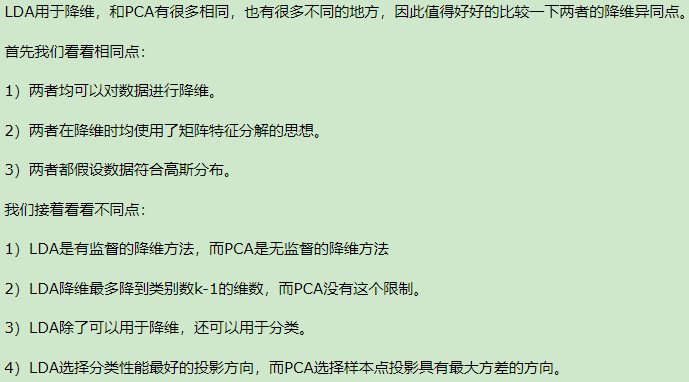
t-SNE(t-Distributed Stochastic Neighbour Embedding)
- 不同於PCA、LDA,t-SNE是非線性、基於概率的降維方法。
- 演算法不同於尋找最大資訊分離的方向,t-SNE將歐氏距離轉化為條件概率,然後對概率應用t分佈。概率應用衡量資料點之間的相似性。
- 實現、視覺化
# Invoking the t-SNE method
tsne = TSNE(n_components=2)
tsne_results = tsne.fit_transform(X_std)
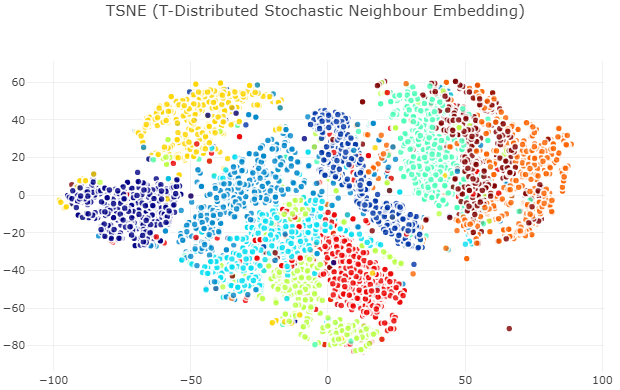
- 相比PCA、LDA,資料點被更直觀的分離,t-SNE更好地保留了資料的拓撲資訊,但t-SNE的缺點是識別叢集會出現多個區域性極小點,可見顏色相同的叢集被分為兩個子群。
參考
- Kaggle入門,看這一篇就夠了
- 大資料競賽平臺——Kaggle 入門
- Interactive Intro to Dimensionality Reduction
- MNIST: PyTorch Convolutional Neural Nets
- kNN from scratch in Python at 97.1%
- 線性判別分析LDA原理總結
